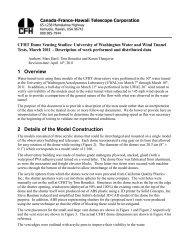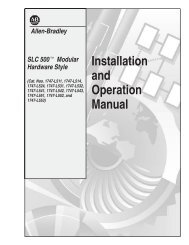2012 CFHT Annual Report - Canada France Hawaii Telescope ...
2012 CFHT Annual Report - Canada France Hawaii Telescope ...
2012 CFHT Annual Report - Canada France Hawaii Telescope ...
You also want an ePaper? Increase the reach of your titles
YUMPU automatically turns print PDFs into web optimized ePapers that Google loves.
<strong>CFHT</strong> <strong>2012</strong> <strong>Annual</strong> <strong>Report</strong><br />
The natural‐color image of the galaxies was taken with NASA's Hubble Space <strong>Telescope</strong> and with the<br />
<strong>Canada</strong>‐<strong>France</strong>‐<strong>Hawaii</strong> <strong>Telescope</strong>. The blend of blue and green in the center of the image reveals that a<br />
clump of dark matter resides near most of the hot gas, where very few galaxies are found. This finding<br />
confirms previous observations of a dark‐matter core in the cluster. The result could present a challenge<br />
to basic theories of dark matter, which predict that galaxies should be anchored to dark matter, even<br />
during the shock of a collision.<br />
Dark Matter Filaments Studied in 3D for the First Time<br />
An international team of astronomers from <strong>France</strong>, the United States, Japan, Denmark, and the UK used<br />
the NASA/ESA Hubble Space <strong>Telescope</strong> in concert with telescopes at the summit of Mauna Kea to study<br />
a giant filament of dark matter in 3D for the first time. Extending 60 million light‐years from one of the<br />
most massive galaxy clusters known, the filament is part of the cosmic web that constitutes the largescale<br />
structure of the universe, and is a leftover of the very first moments after the Big Bang. If the high<br />
mass measured for the filament is representative of the rest of the universe, then these structures may<br />
contain more than half of all the mass in the universe. The team combined high resolution images of the<br />
region around the massive galaxy cluster MACS<br />
J0717.5+3745 (or MACS J0717 for short), taken<br />
using Hubble, NAOJ’s Subaru <strong>Telescope</strong> and the<br />
<strong>Canada</strong>‐<strong>France</strong>‐<strong>Hawaii</strong> <strong>Telescope</strong>. Spectroscopic<br />
data on the galaxies was acquired by the W. M. Keck<br />
Observatory and the Gemini Observatory. Analysing<br />
these observations together gives a complete view<br />
of the shape of the filament as it extends out from<br />
the galaxy cluster almost along our line of sight. A<br />
truly collaborative effort!<br />
Figure 6 ‐ This illustration shows HST’s image of MACS<br />
J0717 overlaid with the location of the cluster and<br />
filament’s mass (in blue).<br />
Very Faint Cluster Orbiting the Milky Way<br />
A team of American, Canadian and Chilean astronomers stumbled onto a remarkably faint cluster of<br />
stars orbiting the Milky Way that puts out as much light as only 120 modest Sun‐like stars – orders of<br />
magnitude smaller than typical globular clusters. The tiny cluster, called Muñoz 1, was discovered near a<br />
dwarf galaxy in a survey of satellites around the Milky Way using <strong>CFHT</strong>’s MegaCam and confirmed using<br />
the Keck II telescope. Muñoz 1's discovery was the result of a survey done with MegaCam in 2009 and<br />
2010.<br />
Strongest Magnetic Field in a Star Ever<br />
Measured<br />
A group of Canadian and US based astronomers used<br />
the Hobby‐Eberly <strong>Telescope</strong> (HET) at the University of<br />
Texas at Austin's McDonald Observatory and <strong>CFHT</strong> to<br />
measure the most magnetic massive star ever<br />
detected. To measure the strength of star's magnetic<br />
field, the team used ESPaDOnS at <strong>CFHT</strong> to measure<br />
small biases in the direction of rotation of the<br />
electromagnetic waves absorbed or emitted by atoms<br />
located in the star’s magnetic field. They determined<br />
that the star's magnetic field is 20,000 times stronger<br />
Figure 7 ‐ The globular cluster Muñoz1 next to the Ursa<br />
Minor Dwarf Galaxy is shown.<br />
<strong>Canada</strong>‐<strong>France</strong>‐<strong>Hawaii</strong> <strong>Telescope</strong> Corporation 8




![Documentation [PDF] - Canada France Hawaii Telescope ...](https://img.yumpu.com/26965302/1/190x245/documentation-pdf-canada-france-hawaii-telescope-.jpg?quality=85)







